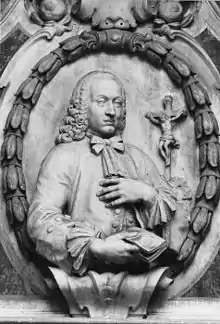Giovanni Battista Pignatelli | |
|---|---|
 Bas-relief of Pignatelli on his tomb | |
| Born | c. 1525 |
| Died | before 1600 |
| Nationality | Neapolitan |
| Other names |
|
| Occupation | Riding instructor |
| Academic work | |
| Notable students | |
| Notable works | L'Arte Veterale |
Giovanni Battista Pignatelli (c. 1525 – before 1600) was a Neapolitan nobleman and riding master.[1]: xix He influenced the development of alta scuola, or classical dressage, both in the Italian peninsula and in France.
Life and work
Pignatelli was born in about 1525, into a Neapolitan noble family originally from Calabria. He was a pupil of Giannetto Conestabile. While some modern sources report him also to have studied under Federico Grisone – also a nobleman of Naples – or Cesare Fiaschi of Ferrara, there is no documentary proof that he did so.[1]: xviii
Pignatelli taught in Naples, where gentlemen came from all over Europe to learn the art of riding. His teaching was innovative: he was among the first to teach the style called a la brida, which was not as severe as the traditional Baroque Spanish a la jineta style.[1]: xxi Among his pupils were Salomon de La Broue, who spent five years under him, Antoine de Pluvinel, who studied with him for six years,[2]: 257 and de Pluvinel's patron the Chevalier de Saint-Antoine.[3]
Pignatelli continued to teach into his old age, but by 1588 his "extreme age" prevented him from doing so.[2]: 254 He died before the end of the century.[1]: xix
Influence and reception
Unlike his many of his contemporaries or successors – Grisone, Fiaschi, Pasquale Caracciolo, Claudio Corte, Pirro Antonio Ferraro, Giovanni Paolo d'Aquino, Paolo de' Pavari – who published treatises on various aspects of horsemanship, many of which were soon translated and circulated through much of Europe, Pignatelli never had any work published. A manuscript of his treatise on the veterinary care and treatment of the horse in the Bibliothèque Sainte-Geneviève in Paris was described in 1838. It was divided into three hundred and seventy-six chapters,[4]: 391 and included sections on cures for parasites and disease, on bridling and on horse management.[4]: 392 A manuscript with the title L'arte veterale is conserved in Verona; a transcription was published in 2001.[1]: xxxi
Through his influence on de La Broue and de Pluvinel – who became riding-instructor to the king of France and in 1594 started the first riding academy in the country – Pignatelli shaped the development of the art of classical dressage, which diffused through Italy and France, but also to England, to the German-speaking world, to Scandinavia, and eventually to the Iberian peninsula.[1]: xxii [2]
In 1576 Prospero d'Osma, who had been a pupil and a collaborator of Pignatelli, was commissioned by Robert Dudley, Earl of Leicester, to prepare a report on the state of Queen Elizabeth's royal stables; d'Osma later opened a riding school in the Mile End district of London.[1]: xxiv [5]: 160
References
- 1 2 3 4 5 6 7 Mario Gennero (2001). Introduction (in Italian). In: Patrizia Arquint, Mario Gennero (editors), Giovanni Battista Pignatelli (2001). L'arte veterale: sopra il medicare et altri secreti bellissimi de' cavalli (in Italian). Bracciano: Equilibri. ISBN 9788887978018.
- 1 2 3 Jean Balsamo (1999). Montaigne, le style (du) cavalier, et ses modèles italiens (in French). Nouvelle Revue du XVIe Siècle 17 (2): 253–267. (subscription required)
- ↑ Monica Mattfeld (2017). Becoming Centaur: Eighteenth-Century Masculinity and English Horsemanship. University Park, Pennsylvania: The Pennsylvania State University Press. ISBN 9780271075778.
- 1 2 Antonio Marsand (1835–1838). I manoscritti italiani della Regia Biblioteca parigina, descritti ed illustrati dal dottore Antonio Marsand (volume II, in Italian). Parigi: Dalla Stamperia Reale.
- ↑ Max Meredith Reese (1976). The Royal Office of Master of the Horse. London: Threshold Books. ISBN 9780901366900.